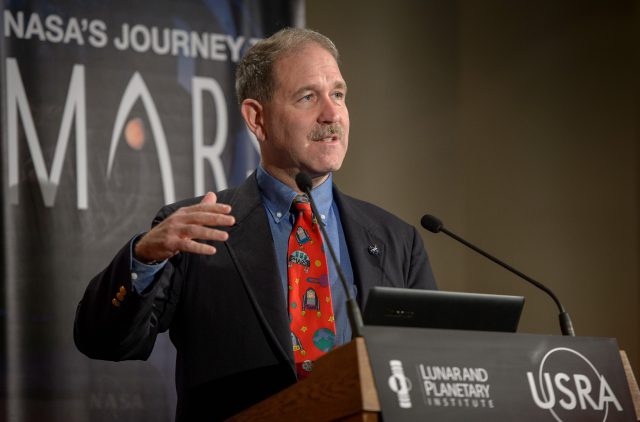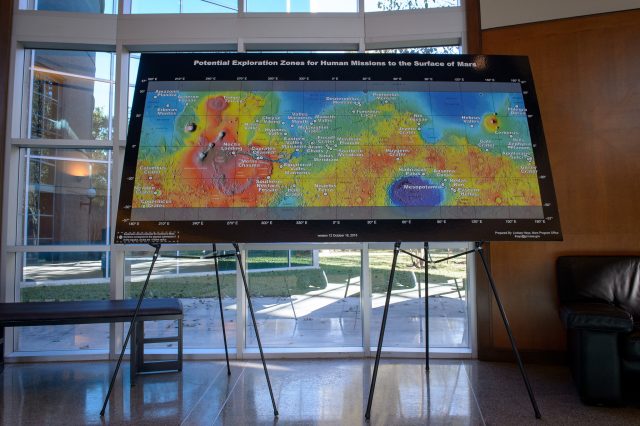
They gathered in a tightly packed lecture hall near the Johnson Space Center just south of Houston with one goal in mind: Mars. For the 150 geologists, planetary scientists, and aerospace engineers gathered in the room, this wasn’t fiction, like the landing on Mars by Mark Watney and the five other crew members in The Martian. These scientists huddled over laptops and notebooks to begin choosing where humans would land on Mars in real life.
Or so they tried to convince themselves.
Leading the discussion was John Grunsfeld—not exactly a household name, but certainly one of the most decorated astronauts of the space shuttle era. He flew five times in space, including three repair missions to the Hubble Space Telescope. Now that the physicist and self-described “Hubble hugger” has retired from spacewalking, he oversees NASA’s $5 billion science budget.
At the outset of the meetings this week, he recalled how his class of astronauts in 1992 was told they would be the first group to return to the moon and then set foot on Mars. That hasn’t happened, of course. His classmates—and all who have come after—haven’t even left low-Earth orbit. Nevertheless, Grunsfeld still yearns to land people on Mars, and he characterized the Houston meeting as the real beginning of that journey. “We have a long road ahead of us,” he acknowledged. “But this time, and with this group of people and this effort, let’s really do it.”
History of Mars planning
Like with fusion technology, it seems that NASA is perpetually 20 years away from Mars. Just a few months after President Eisenhower established NASA in 1958 and fully two years before Alan Shepard’s suborbital flight, the agency had already begun working on its first study of a Mars mission. Scientists at a NASA center in Cleveland devised a 420-day mission with a nuclear-powered rocket to send seven astronauts to Mars. They were to stay on the red planet for 40 days.
During the next four years, similar studies were done at NASA centers in Huntsville, Alabama and Houston. Such exuberant efforts continued until 1965, when Mariner 4 performed the first successful flyby of Mars. The 21 images it returned showed a lifeless, cratered world ill-suited to human habitation. The Mars ardor within NASA cooled.
It has ebbed and flowed in the five decades since. Grunsfeld recalled a time in the 1990s when Mars landings were such a taboo subject due to projected high costs that in presentations about human operations on the red planet, the agency didn’t refer to it as Mars but rather as a “human accessible surface.”
Times have changed. During the last five years, NASA administrator Charles Bolden has repeatedly said the space agency will land humans on Mars in the mid-2030s—in 20 years. The #JourneyToMars hashtag is ubiquitous on NASA’s social media channels. The reality is that while NASA is building some tools to reach Mars, such as a giant but costly rocket called the Space Launch System, it does not have the budget to achieve the goal any time soon. All of which explained the uncertain-but-hopeful atmosphere in the south Houston lecture hall this week.
During the discussions, some interesting details about the kind of landings NASA is planning on Mars did emerge. Instead of following an Apollo-like approach to land each successive crew at a new site as NASA did on the moon, under its new “Evolvable Mars Campaign,” the space agency intends to identify the single-best “exploration zone” for all future crews to land in and develop.
Exploration zones
Such zones would have a radius of about 100km because that’s the distance a pressurized rover could cover in two weeks. Within the ideal zone, there would be multiple scientific points of interest as well as local resources to sustain crews on the red planet. “We’re planning to invest a lot in one site,” said Steve Hoffman, a Houston-based aerospace engineer who is helping to develop criteria for the landing site.
Under the new plans, multiple crews would land at the chosen site, each for a duration of 300 to 500 sols, or Martian days, which last 24 hours and 40 minutes. Hoffman said the most important resource astronauts would need access to is water, for a variety of uses, including the manufacturing of propellant, drinking, cooling in EVA suits, and growing plants. The water feedstock could come in the form of ice, hydrated minerals, or other things, and ideally there would be more than one source in an exploration zone.
And there needs to be a lot of water: 100 tons. Hoffman and his engineers estimated that it would require 20,000kg of water to produce the propellant needed for a single Mars ascent vehicle that would return astronauts from the surface to orbit. So 100 tons could accommodate five crews.
In addition to water, a suitable zone should also include metals and other structural building materials that would allow astronauts and machines to manipulate the Martian surface. Hoffman envisioned using local materials to build foundations, landing pads, roads, berms and other infrastructure. Each crew would add to the burgeoning Mars settlement.

“I consider this probably a better way to go because it indicates a more serious perspective,” Hoffman said. “If you go to one place and quit, that may be the only place you go. If we are now talking about investing in a spot and going back there repeatedly, and doing this like growing crops and building roads, that is at a different level than some of the discussions we’ve had in the past.”
At the heart of NASA’s new plans is the concept of in-situ resource utilization, or living off the land. Every drop of water collected on Mars is one drop less that needs to be launched from Earth and propelled through 100 million kilometers of space. This ultimately could save NASA tens or even hundreds of billions of dollars in launch costs, potentially making a Mars plan affordable.
The point of this week’s meetings was to foster collaborations between NASA’s human exploration engineers and Mars scientists that would begin to identify a multitude of potential exploration zones. This would allow NASA to use its considerable fleet of orbiting spacecraft, such as the Mars Reconnaissance Orbiter and Mars Odyssey, to study them in further depth. NASA has only surveyed about three percent of the planet in great detail.
“While a human landing on Mars is still awhile off, we can make good use of existing assets around Mars,” said Ellen Ochoa, Johnson Space Center’s director.
But whether finding the ideal site rich in water and scientific interest would spur actual human landings remains far from clear. To date, the agency’s Congressional taskmasters have budgeted billions of dollars for rocket and spacecraft building, which provide lots of constituent jobs but substantially less for the kinds of technology breakthroughs to make living off the land feasible.
Extracting 100 tons of water from Mars, a largely dry, distant world, would be no simple matter. Until the agency starts to develop and test some of the techniques and machines that would allow it to do so, human landings on Mars will probably remain more the stuff of Hollywood than Houston.
reader comments
103